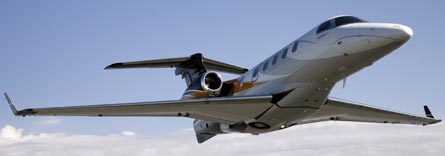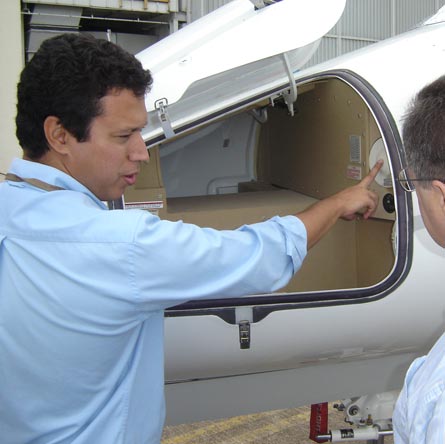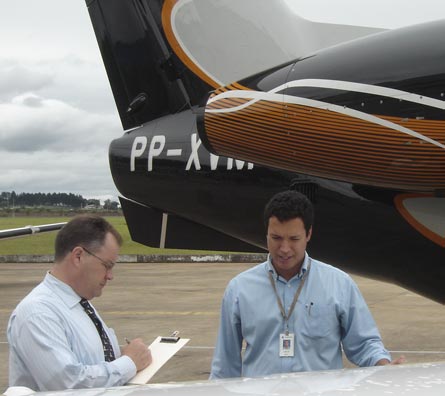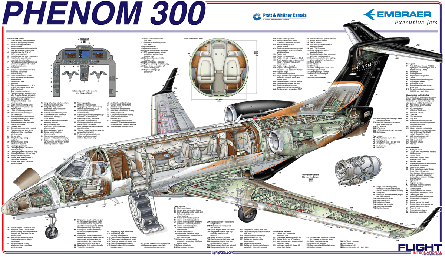When Embraer put its corporate weight into developing a robust line of executive jets it started in the middle with the midsize Legacy 600, an adaptation of its prolific ERJ-135/145 series of regional jets.
With its 2005 launch of its Phenom executive jets, Embraer sought to stake out the high ground in the entry-level and light jet segments. Its first offering, the Phenom 100, was positioned well above the then teeming very light jet segment. The Phenom 100 offered performance that eclipsed the original VLJ (Eclipse 500) and was on par with the more expensive Cessna CJ1+.
|
|---|
Hawker Beechcraft had recently rebranded its product line, with Beechcraft aircraft being single-pilot certificated and Hawkers approved for dual pilot operations. Unlike Hawker Beechcraft, Embraer has chosen to brand its executive jets based on cabin size; Legacy aircraft offer stand-up cabin height while the smaller Phenoms do not.
While the Phenom 100 and 300 share a common name, similar cockpit and fuselage cross-sections, they are two distinct aircraft.
Both Phenoms feature Embraer's "Oval Lite" fuselage cross-section that offers improved room at the lower sidewall and a class-leading height of 1.5m (4.9ft). The 300's 5.23m-long cabin offers seating for six passengers in its standard configuration, two more than in the 100's 3.35m-long cabin. Both feature 0.107m2 (1.15ft2) windows, eight for the 300 and six for the 100. These large, well-positioned windows give the cabins an open and airy feeling.

DESIGNED FOR SPEED
The 300 is nearly twice as heavy as its smaller brother. Its extra weight is put to good use as the 300 flies further higher and faster than the 100. And the 300 is designed for speed. Its higher wing loading and mildly swept wing indicate its design cruise speed is higher than that of the straight-winged 100. The 300's relatively higher fuel fraction also shows it was designed to be a longer-range machine than its smaller stablemate.
The Phenom 300 trailed the 100 to market by almost exactly one year when it received US Federal Aviation Administration and Brazilian certification on 3 December 2009. And while the comparison highlights the 300's advantages over its smaller sibling, the 300 is designed to take on the likes of the Beechcraft Premier IA, Cessna CJ3 and CJ4, and Hawker 400XP. With European Aviation Safety Agency certification nearly in hand, Flight International was invited to see how the Phenom 300 compared with its lightweight rivals.
|
|---|
RAMP PRESENCE
When I flew the Beechcraft Premier I in 2001, I remember being struck by how substantial it appeared on the ramp as we approached it. As I walked out to our Phenom 300 demonstration aircraft (PP-XVM) at Embraer's production facility in São José dos Campos, the Premier I suddenly did not seem so substantial. The Phenom 300 is a solid-looking machine with proportions more befitting a midsized aircraft than a light jet. In the sunlight, the polished silver bleed air de-iced wing and horizontal stabiliser leading edges glistened.
I accompanied Capt Marcio Miranda, Embraer instructor pilot, as he performed the pre-flight walkaround inspection. On the exterior the aircraft, the fifth to be built, was production representative with minor exceptions. During the development process, Embraer had removed the originally installed leading edge vortilons, designed to increase aileron effectiveness at high angles of attack.
|
|---|
These devices are installed on the Legacy 600 and ERJ-135/145 series of aircraft. Perhaps because of the end plate effect of the 300's winglets, they were not needed to ensure acceptable handling qualities and were removed. Aluminium tape covered the holes in the leading edge left by vortilon removal. A door at the right leading-edge wing root allowed access to the single point refuelling panel.
Aft of the wing was another panel for lavatory service, a nice feature on an aircraft with nearly 5h endurance. Like the Phenom 100, a ventral fin is installed on the 300, but unlike the 100 it has rudder surface. During normal operations the ventral rudder is unpowered and streamlined. In the event of failure of the primary yaw damper, which actuates the main rudder, it acts as a back-up yaw damper. Access to the large 1.87m3 (65.9ft3)/210kg (460lb) aft baggage is via a door beneath the left-engine nacelle.
The Phenom's entrance door and air stair is 1.47m high and 0.74m wide, far larger than that of any other jet in its class. Dimensionally the Bombardier Learjet 40XR's split door is slightly larger than the 300's, but it appears less substantial and welcoming than the 300's. The cabin on our demonstration aircraft, while fitted to a high standard, was not production representative.
The standard cabin has seating for six in a club forward configuration with a sizable galley area opposite the entry door. An optional seventh seat can be placed opposite the entry door, with a small cabinet replacing the standard galley. The aft-located lavatory is separated from the cabin by a hard partition and door. The lavatory seat can be belted, giving the 300 a total seating capacity of 10 (two in the cockpit). As with the 100, the 300's cabin was developed in association with BMW Group Designworks with the goal of providing a custom cabin at a mass production price.
|
|---|
GLASS ON STEROIDS
The well-arranged cockpit is separated from the cabin by a curtain. With the exception of the forward overhead light switch panel, all switches and displays are located on the forward instrument panel. System operation panels are on the lower edge of the instrument panel. No system panels are located outboard of the right hand yoke to keep everything within easy reach for single-pilot operators.
Three 31cm (12in) displays, each with integral bezel buttons, form the face of the Garmin G100-based Prodigy avionics suite. For normal operations the two outboard displays are primary displays, with the centre functioning as a multifunctional display. The primary displays feature full span horizon lines that greatly enhance attitude awareness. The multifunction display can show system synoptic pages as well as an electronic checklist.
Based on my experience with various G1000 systems, I can lend credence to Embraer's claim that Prodigy is a G1000 on steroids. Above the three displays, just below the glareshield, are the flight guidance control panel and integrated electronic standby instrument (IESI). The Thales-supplied IESI has its own pitot static and attitude heading reference system sources.
Settling into the left seat, I found a position that allowed the Embraer trademark "motorcycle" yoke to fall readily to hand. The 300 does not have design eye position alignment balls on the centre pillar like the 100, but I found that with the seat fully up I could see down the glareshield and all three large panel displays.
Pre-start flows were minimal, with the standard vapour cycle air conditioner keeping the cockpit cool. Once the external power cart was disconnected, the engines were started from internal battery power alone. FADEC-controlled starts were rapid, each engine reaching idle power in less than 30s. Peak observed start inter-turbine temperature of 500e_SDgrC (932°F) was on the No 2 engine - the first started - and well below the limit of 896e_SDgrC. Had there been a hot, hung or no start the FADEC would have worked to ensure no limits were exceeded.
Post-start flows were a model of simplicity, with the 300 rolling slowly forward when the parking brake was released. The rudder pedals controlled the nosewheel steering, which offered +/-20e_SDgr of displacement. Nosewheel steering, when combined with differential braking, yields a displacement of 43e_SDgr, a feature sure to be handy in tight parking spots but not tested during my flight.
During the taxi to Runway 15, I found the nosewheel steering allowed me to keep the 300 on taxiway centrelines with ease. Several 90e_SDgr turns were easily negotiated. Like the 100, the 300 has a brake-by-wire system, but it has carbon disks in place of steel ones. In addition to being 20% lighter than steel disks, carbon brakes are less susceptible to distortion and degradation at elevated temperatures.
While I found the brake-by-wire offered good control of the 300's stopping power, pedal ergonomics were not quite right. Too much ankle rotation was required before appreciable braking was felt.
Before taking the runway, I pushed the take-off configuration button located on the throttle pedestal. An engine indicator and crew alert system message as well as an aural advisory message assured us that the aircraft was in an acceptable take-off configuration.
Four occupants gave a test day zero fuel weight of 5,625kg. Our 1,570kg fuel load was less than the maximum of 2,428kg, and gave a take-off gross weight of 7,195kg, well under the listed 8,150kg maximum take-off weight.
|
|---|
 RAPID TAKE-OFF
RAPID TAKE-OFF
With flaps set to position 1, calibrated reference airspeeds were: V1/VR 102kt (188km/h) and V2 112kt. With a test day thrust (N1 90%) to weight ratio of about 0.424, acceleration down the runway was brisk. Moderate aft yoke pressure was needed to attain the desired take-off pitch attitude of 11e_SDgr.
The 300 leapt off the runway after a ground roll of less than 700m. Once the landing gear was retracted and a pitch attitude of 20e_SDgr was needed to hold a calibrated speed of 132kt. At 1,000ft above the ground, the flaps were retracted and initial climb speed of 230kt captured. Minor pitch force changes during initial clean-up and climb-out were readily nulled with the electric stabiliser pitch trim.
At maximum take-off weight on standard day conditions, Embraer says the 300 can climb directly to 45,000ft, but for our test we would only climb to 41,000ft. I aligned the thrust levers to the CON/CLB marking on the throttle quadrant. In the climb the FADECs kept the engines at the desired thrust setting.
I hand-flew the aircraft in the initial portion of the climb to get a feel for the conventional flight controls. During the multiple air traffic control vectors, I found the 300's control well balanced, allowing for accurate capture and tracking of assigned headings. Passing FL300, a climb speed of Mach 0.62 was captured and held by the autopilot, which was engaged in the heading and flight level change modes.
Reaching FL410, the autopilot captured and held the cruise altitude of FL410. Due to the numerous air traffic control vectors, several intermediate level-offs and hotter than standard conditions, actual time and fuel burn to FL410 were slightly higher than the published book values of 14min and 210kg.
The aircraft was allowed to accelerate with the thrust levers still set to CON/CLB (90.8% N1) for around 5min, then they were retarded to the maximum cruise setting (85.9% N1). The aircraft stopped accelerating at 222kt and M0.756. Test day conditions were ISA 9e_SDgrC, and the observed indicated high-speed cruise was 431kt, with a total fuel flow of 456kg/h, matching book data for our conditions.
Next I used the speed brakes to slow the aircraft to a long-range cruise calibrated speed of 185kt/M0.635. Total fuel flow was only 346kg/h with the aircraft holding an indicated speed of 364kt. As with the high-speed cruise condition, the observed long-range cruise condition closely matched book predictions. With a total of six occupants the Phenom has a range of 3,650km (1,970nm).
Aside from a high cruise speed and a quiet cabin environment, one other way to reduce the fatigue of a long flight is to have a low cabin altitude. The champion in the light jet arena is the Emivest SJ30, which boasts a sea-level cabin all the way to FL410. While the 300 cannot match these numbers, its 6,600ft cabin altitude at FL450 (0.64bar/9.3lb/in2) is the lowest of the remaining light jet competition.
Before I left the cockpit to sample the cabin, I noted actual cabin altitude was slightly less than 6,000ft, with a pressure of 0.63bar. The test aircraft's cabin was not production representative and lacked sound deadening found in customer aircraft.
Sitting mid-cabin I was able to hold a conversation at normal voice levels, noting the acoustical environment was on par with many other business jets I had flown. One minor annoyance on any multi-engine aircraft is engine resonance. During cruise the 300's FADECs can synchronise the engines and further enhance an already pleasant cabin experience.
After strapping back into the left seat I started a descent out of FL410 to FL390 where I did a series of 60e_SDgr angle of bank steep turns. The turns were flown with my feet on the floor at a calibrated airspeed of 200kt. No airframe buffet was felt and the yaw damper smoothly countered any adverse yaw generated.
After completion of the steep turns, a descent was started to 10,000ft for an evaluation of the Phenom 300's slow-speed handling qualities. During the descent I left the power up and allowed the aircraft to accelerate to VMO of 320kt calibrated airspeed. In addition to an overspeed indication on the primary display's airspeed tape, an aural, "high speed" warning was annunciated.
At VMO, in idle power, sharp control inputs showed the Phenom's response to be well damped in all three control axes. Speed brake extension caused a slight pitch-up, that was easily countered with less than 3kg of forward yoke force. Raising the nose further slowed the aircraft to a calibrated speed of less than 300kt.
With the speed brakes still deployed, I advanced the power, and the speed brakes automatically retracted, a feature that definitely increases safety. An EICAS message confirmed speed brake retraction, and placing the pedestal mounted speed brake switch to up extinguished the message.
During my flight evaluations I seek to evaluate slow-speed handling qualities to the fullest extent possible. How deep into the slow-speed regime I am allowed to go is determined by the characteristics of the evaluation aircraft and the demonstration/safety pilot.
On some aircraft I am only allowed to do an approach to stall, recovering to normal flight conditions at the first stall indication. In others a fully developed stall can be safely experienced. Needless to say I much prefer to do the latter. Pilot response to stalls has received increased attention, primarily because of the recent fatal air carrier crash in Buffalo.
POST STALL
In the USA stall training for air carrier pilots is limited to the approach to stall scenario. On evaluation rides the "stall" and recovery is typically evaluated as an instrument proficiency manoeuvre with the goal of a smooth minimum altitude loss recovery. Pilots are taught initially to reduce angle of attack to break the stall, roll wings level and apply maximum power. The aircraft is then powered out of the "stall" in straight and level flight. This is a great training exercise, but may not adequately prepare the pilot for what might happen if the aircraft is slowed even further.
During several evaluation flights of Embraer aircraft I have been allowed to go well beyond the initial "stall" indication and see how their aircraft handled at the extreme. In the Phenom 300, Miranda indicated this flight would be no different. At FL100 and a gross weight of 6,600kg I slowed the clean configuration Phenom in wings level flight and idle power. At a calibrated speed of 114kt the airspeed tape turned amber, to indicate an approaching slow speed condition. At 108kt, 1.3Vs, the airspeed tape turned red and an aural, "stall stall" was sounded. I continued to hold aft yoke pressure, further slowing the aircraft. At 93kt the hydraulically powered stick pusher fired. The pusher drove the yoke forward, reducing the angle of attack and helping me start the recovery process. Throughout the deceleration, response to small control inputs in all three axes was good, allowing for controlled flight all the way to the extreme. Even after the pusher fired, the Phenom stayed wings level, allowing for rapid and predictable recovery.
The next stall was in the landing configuration, landing gear down and flaps 3. Aside from up, the 300 has four flap settings. During development Embraer had found that the flaps 3 position gave all the performance needed, and the 4 position has not been certificated for use. Slowing the aircraft in idle power and level flight, the amber low speed indication in the primary display was 108kt. There was no aerodynamic warning before the "stall stall" aural warning was at annunciated at 96kt.
At 85kt the stick pusher fired, but I continued to hold aft yoke pressure further, slowing the aircraft further. Several knots below the pusher speed, the right wing gently rolled off. I simultaneously reduced yoke back pressure and rolled wings level while advancing the thrust levers. The Phenom quickly returned to controlled flight and retracting the gear and flaps once level completed the manoeuvre.
Pilots are not supposed to let their aircraft slow to an unsafe speed. The Phenom, while lacking aerodynamic cues, provided several indications of the approaching low-speed condition. The stick pusher is a common device in T-tail aircraft, and only after ignoring it and muscling the yoke aft did the Phenom exhibit any untold behaviour.
Why did the right wing roll off? Aircraft and flight forces are never perfectly symmetrical and every aircraft I have flown will eventually drop a wing when provoked. Training to cope with stalls and spins could be improved. Designers continue to build safer aircraft, yet pilots still find ways to stall and spin them.
SYNTHETIC VISION
After completing the intermediate altitude manoeuvres, return to São José dos Campos was via radar vectors to an autopilot-coupled instrument landing system approach.
I further familiarised myself with the Prodigy avionics. In addition to an electronic checklist and graphic system synoptic pages, it had the ability to incorporate electronic charts. This was also the first time I had been exposed to a synthetic vision system. Over the gentle rolling terrain on our route back, the primary display was not much different than a conventional attitude indicator. There was a full span horizon line, just like on a normal primary display. Terrain elevation could be made out however, and the south Atlantic was depicted as we approached São José dos Campos.
Traffic collision avoidance system traffic, if within the display's field of view, is shown in its relative position in both azimuth and elevation, a very nice feature. Where I would find the synthetic vision most useful, however, was in the heads-down to heads-up transition during the ILS approach. The runway is realistically depicted in aspect and orientation, priming the mind's eye for what the landing environment will look like as minimums are reached. The synthetic vision depiction is only as good as the terrain database and derived aircraft position and as such is only an aide.
As an infrequent G1000 user I have found its bezel-mounted rotary/push knob interface to be adequate at best. The 300 has an instrument panel mounted flight management system keyboard, which was used to select and activate the ILS Runway 15 approach.
I found the keyboard interface more user friendly and more indicative of a real business jet. The flight management system automatically tuned the LOC frequency, further reducing pilot workload. GPS position information was used by the FMS to guide the aircraft until the LOC final approach course was captured.
The landing gear was extended and flaps set to position 3, before glideslope capture. The autopilot smoothly tracked the LOC and GP, as I modulated thrust to hold a target calibrated speed of 106kt. Passing 1,000ft AGL I disengaged the autopilot and hand-flew the final portion of the approach.
At minimums, 200ft AGL, I went heads-up and aided by the synthetic vision display rapidly visually acquired the runway. Passing the threshold I retarded the power to idle.
Miranda assured me it was acceptable to land the 300 without flaring, but ingrained habits got the better of me as I gently pulled the nose up a few degrees just before touchdown. The wing mounted fly-by-wire multifunction spoiler panels deployed on touchdown to act as ground roll spoilers. Light braking quickly slowed the aircraft to taxi speed, turning off the runway at mid-field.
ENGINE-OUT MANOEUVRES
One the most demanding situations a multi-engine pilot may face is the loss of an engine during a critical flight phase. During the taxi, the flaps were set to position 1 in preparation for an engine failure on take-off scenario. Take-off calibrated speeds with 700kg of fuel remaining were: V1/VR 98kt, V2 110kt and flap retraction speed of 120kt.
Acceleration on the second take-off roll was brisker than the first, as I eagerly awaited the impending engine failure. Once airborne, after the landing gear lever was placed up, Miranda pulled the right engine to idle. Sensing the yaw, I immediately put in a healthy amount of left rudder. Nearly full left rudder, over 60kg of force, was needed to keep the Phenom tracking down the extended runway centreline.
Full left rudder trim reduced the rudder force needed for co-ordinated flight in the climb out by about half. Once level on downwind at 200kt, with the flaps retracted, about half of the available rudder trim was needed to null out rudder forces.
Configured on final, flaps set to 3, I set the rudder trim to neutral and used my feet to co-ordinate the final approach. Target speed was increased 10kt to 116kt, to give an added margin of safety for the "engine-out" condition. The simulated engine-out approach and landing was facilitated by the responsive Pratt & Whitney Canada PW535E engine. On this approach I flared a bit less than the first, the firm touchdown absorbed by the compliant trailing link main landing gear.
Embraer is the last to market with its high-end light jet, and it has raised the bar. It has also delivered a more capable jet than promised at launch. The certificated Phenom 300 offers better runway performance and 316km more range than the promised 3,334km.
I was impressed by the Premier I, but the Phenom 300 eclipses it on all fronts. Priced less than a CJ3, it offers a larger cabin cross-section and with the exception of range, matches or exceeds the CJ4's capabilities. Priced much less than a Learjet 40XR it has a slightly larger passenger cabin with much greater range and payload flexibility.
With the Phenom 300, Embraer takes a robust airframe and couples it with an outstanding Prodigy avionics system to field a long-range aircraft that is dollar for dollar the arguably the best light jet on the market.
Related
Source: Flight International






















